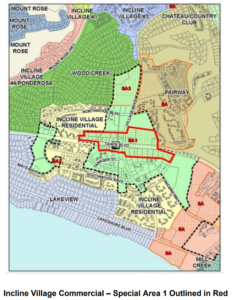Tahoe’s Future Hangs in the Balance….Again
TRPA Governing Board,
As a full-time resident of Incline Village, NV, I write to express my deep concern about a number of new developments and amendments that TRPA will soon rule on.
Among other things, you will be asked to amend the Washoe County Tahoe Area Plan. I urge you to not approve this amendment. It is solely meant to accommodate one commercial developer’s plans to build a luxury condominium complex. This amendment will also alter the entirety of Special Area 1 (see illustration attached).
At a minimum, this project should be subject to an independent environmental impact study as well as externally-assessed traffic and infrastructure impacts. I have laid out my full arguments in the attached Reno Gazette Journal piece, published March 16, 2023.
TRPA has a responsibility to protect and ensure that Lake Tahoe and the Tahoe Basin are not endangered. Recent wildfires and extreme weather events, such as this winter’s record-breaking snowfall, have elevated the need for an up-to-date emergency evacuation plan that takes into account the many tourists, visitors and full-time residents who routinely face life-threatening long waits on narrow roads never meant to hold the number of vehicles that now fill the Tahoe Basin.
Further, TRPA’s single project environmental checklist (which allows TRPA and developers along with Basin counties to sidestep an overall EIS) works against Tahoe Basin’s preservation. There needs to be governing board discussion and action regarding basin-wide cumulative impacts, including over capacity.
TPRA must revisit and perform a basin-wide cumulative effect/impact EIS based on changing conditions since the 2012 Regional Plan. Until this is completed, TRPA should halt any further work associated with:
• Washoe Tahoe Area Plan
- Placer Tahoe Area Plan
- Proposed height, density and coverage Regional Plan amendments
- Major Resort projects
Please read and consider the arguments and source material included in my article below and attached. Thank you, Pamela Mahoney Tsigdinos

Tahoe’s Future Hangs in the Balance – Again
By Pamela Mahoney Tsigdinos
The Tahoe Regional Planning Agency (TRPA) governing board will convene with a pivotal item on its agenda as soon as March 22. Few of Tahoe’s 55,000+ residents have time to monitor TRPA, but now is the time to pay attention.
That’s because this bi-state agency’s governing board decisions determine the Tahoe Basin’s future. Formed in 1969, TRPA is mandated to protect the Basin through land-use regulations; development has been limited intentionally.
The first Tahoe Area Regional Plan contained scientific underpinnings and vital evaluations that formally introduced the concepts of carrying capacity and environmental thresholds to protect the Lake and its environment. Last fully updated in 2012 to allow area plans and amended in 2021, each Regional Plan revision has further undermined TRPA’s once strict land use rules, threatening the Lake.
Unintended Consequences
Tahoe Basin residents and local business owners know well that affordable and workforce housing is in short supply in large part based on a short-sighted 2004 TRPA governing board decision approving short-term rentals (STRs) as a permitted “residential use.” This led to the conversion of thousands of condos and houses, once available as long-term rentals for locals, to become STRs for tourists. This drastically reduced local housing options throughout the Tahoe Basin.
Washoe County’s Tahoe Area Plan (TAP), last updated in 2021, followed years of careful deliberations and community input. To encourage development of more affordable housing, Washoe County’s TAP mandated that “single family dwellings shall only be allowed in the Incline Village Commercial regulatory zone when they are part of a mixed-use development or when they are affordable housing units.”
Working against its own affordable housing goals, the Washoe Board of County Commissioners in January inexplicably voted to advance to TRPA an Area Plan amendment to allow luxury condominiums in an area originally limited to mixed use affordable housing and commercial.
These 40 units, already advertised online starting at $2.5M, are not affordable to a first responder, schoolteacher, healthcare, or service worker. Worse, the developer’s amendment encompasses all Special Area 1 and doesn’t define how much of the mixed-use project must be commercial space. The County and the developer team erroneously claim this significant TAP amendment won’t produce environmental or traffic impacts.
It’s misleading for the County to say the amendment will not have broader impacts. If TRPA greenlights it, this code change will be the impetus for redevelopment along SR 28 and beyond. This large area along Tahoe Boulevard, zoned commercial until the 2021 Area Plan change, could become high-rise luxury condominiums effectively pricing out many locals as well as existing small businesses now in SA1.
Broad redevelopment deserves comprehensive and well-publicized community engagement as part of a larger TAP revision process — not one-off amendments pushed through for the convenience of developers.
This code change would not only lessen the probability of affordable housing across the Basin, but it would clear the way for increasing the height and density of structures throughout the Basin.
If TRPA’s governing board approves the proposed TAP changes it would unravel 50+ years of work to prevent the build out of the Tahoe Basin and exacerbate existing overtourism problems.
Increased density puts Basin communities and visitors at risk in the event of an emergency evacuation. It also increases air and water pollution. That’s because increases in people and density bring increases in cars, boats, and recreational vehicles and related emissions and trash, including micro-plastics and algae, responsible for a 70% Lake clarity loss, according to the latest UC Davis report.
Developers are queuing in anticipation.
Developers Tried Before to Control Tahoe
Will the Tahoe Basin remain a natural wonder, or will it be sold off to the highest bidders?
Developers and government officials hungry for revenue and tax windfalls at the expense of the Lake environment aren’t new. They were foreseen in a California Law Review article in 1964:
“The unwillingness of the five counties to subordinate sectarian economic interests in rapid growth and development of the lake basin to the national interest in preserving the lake as a natural resource has been manifested not only in deficiencies of the present zoning laws, but also in frequent departures from existing controls. Responsibility for inadequacies in approach lies partly with local government operating in county seats geographically and economically removed from the Lake Tahoe basin and partly with the permanent residents. Neither group has recognized that Tahoe must be protected with restrictions on private enterprise in the interest of conservation. Strong limitations are as appropriate at Tahoe as in any national park. A thriving metropolis characterized by towering skyscrapers and blazing neon signs is no more appropriate at Tahoe than at Crater Lake, Yellowstone, Yosemite, or other of the nation’s exceptional physical assets.”
It’s worth noting none of the five Washoe County Commissioners and only 3 of the 14 TRPA governing board reside in the Tahoe Basin.
The Law Review authors held out hope that a new governing body would prevent destruction of the Tahoe Basin, writing that a:
“Tahoe Regional Planning Commission offers grounds for optimism with respect to sound area development…the master plan proposed by this agency provides a firm starting point for regulation of Lake Tahoe’s future growth.”
One of a Kind Natural Beauty Requires Protection
The Tahoe Basin straddles Nevada and California. Nevada’s side holds seven communities in Douglas County and two in Washoe County. California’s side includes one city (South Lake Tahoe) and eight communities within two counties, Placer and El Dorado. All rely on one two-lane ring road around the Lake to reach one of a handful of rural highways into and out of the Basin. The Caldor wildfire and extreme weather events highlight just how critical these roads are to public safety, particularly when they’re closed due to natural disasters such as this winter’s dangerous snow accumulation.
During the past century, there have been several attempts to put massive developments in Tahoe. Each time stewards of the lake, particularly volunteer groups like the League to Save Lake Tahoe, the Village League, Mountain Area Preservation Foundation, North Tahoe Preservation Alliance, Friends of West Shore, Sierra Watch, Save Tahoe Forests, Sierra Forest Legacy, and Tahoe Area Sierra Club have mobilized to protect the Tahoe Basin and guard the Lake’s clarity so future generations can experience Tahoe’s unblemished natural beauty.
Housing Priorities and Environmental Impact Reviews
Tahoe, without the proposed developments, already gets an estimated 60 million visitors each year to its 207,000 acres. The Great Smokey Mountains, the National Park with the most annual visitors, gets only 14 million to its 522,419 acres. Given its singular beauty and priceless ecosystem, Tahoe deserves the same care and respect afforded to our nation’s other most precious natural assets.
TRPA is also in the process of considering new rules that would allow increased height, density, and coverage for buildings within town centers to attract developers, presumably, to build affordable housing in the Tahoe Basin. Residents voiced disapproval. Critically missing right now are:
– a Basin-wide cap on STRs;
– strict, enforceable controls on how any new housing will be used;
– a traffic study and evacuation plan that includes all residents and visitors;
– an honest, comprehensive Environmental Impact Study that looks at the totality of the proposed new developments and their simultaneous impacts on the Basin and the Lake.
TRPA has effectively skirted a thorough Environmental Impact Study by approving one development at a time, allowing developers — and local government agencies favoring development and more tax revenues — to determine there are no impacts. That’s letting the fox design the hen house.
TRPA risks losing its credibility and community trust if it prioritizes frivolous luxury developments over its duty to be Lake Tahoe’s watchdog and protector. Community members can voice their concerns to TRPA about Area Plan amendments and other code changes by sending emails to jstock@TRPA.gov and the governing board directly, or public comments to mambler@TRPA.gov
Pamela Mahoney Tsigdinos lives in Tahoe and volunteers with grassroots Tahoe Basin groups. She was not paid to write this piece.
~~~
Pamela Mahoney Tsigdinos
Full-time resident of Incline Village, NV
Connect: ptsigdinos@yahoo.com


